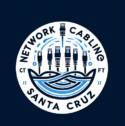What Type of Cabling Is the Most Secure for Networks?
When it comes to building a fast and reliable network, security is just as important as speed. Whether you’re setting up a home office, a corporate data center, or a commercial facility, choosing the most secure type of cabling can protect your data from interference, signal loss, and even cyber threats.
So, what kind of cabling offers the best security for your network? Let’s break it down. Our team of structured cabling experts in Santa Cruz ensures every installation meets the highest security and performance standards.
Why Cabling Security Matters
Every cable in your network carries sensitive information — emails, financial data, video calls, and more. If your cabling system is poorly shielded or incorrectly installed, it can create vulnerabilities like signal leakage, electromagnetic interference (EMI), or physical tapping.
By using the right type of cable and professional installation, you can:
- Reduce the risk of external interference
- Maintain strong signal integrity
- Protect confidential data
- Comply with cybersecurity and data privacy standards
Simply put, secure cabling forms the physical layer of a trustworthy network.
1. Shielded Twisted Pair (STP) — The Best Balance of Security and Performance
For most businesses and high-security networks, Shielded Twisted Pair (STP) cables are the go-to choice. These cables have an extra layer of shielding — either foil or braided mesh — that protects the internal wires from electromagnetic and radio frequency interference.
Why STP is secure:
- Prevents data leakage and cross-talk between cables
- Reduces interference from electrical equipment
- Ideal for environments with heavy machinery or multiple electronic systems
Best use cases:
- Financial institutions
- Hospitals
- Industrial and commercial facilities
- High-density office environments
STP cables are slightly more expensive than unshielded ones, but the improved protection and performance are worth the investment.
2. Fiber Optic Cable — The Most Secure Option Available
If you want maximum network security, fiber optic cabling is unbeatable. Instead of using electrical signals, fiber cables transmit data using light, making them immune to electromagnetic interference and extremely difficult to tap without detection.
Why fiber is the most secure:
- Immune to signal interference or data leakage
- Virtually impossible to intercept without breaking the line
- Supports extremely high bandwidth and long-distance connections
Best use cases:
- Data centers and enterprise networks
- Government and defense installations
- Cloud computing facilities
- Large organizations handling sensitive data
While fiber installation can be more complex, it provides unmatched security and future-proofing.
3. Unshielded Twisted Pair (UTP) — Common but Less Secure
UTP cables are the most commonly used in homes and small businesses. They’re affordable, flexible, and easy to install. However, since they lack shielding, they’re more prone to interference from nearby cables or electrical systems.
Why UTP is less secure:
- Vulnerable to EMI and cross-talk
- Easier to intercept or compromise
- Better suited for low-risk, smaller environments
Best use cases:
- Home networks
- Small offices with minimal interference
- Low-voltage or short-distance connections
If security isn’t your top concern and you’re on a budget, UTP cabling can still provide solid performance when properly installed.
4. Plenum-Rated and Fire-Resistant Cabling — Safety Beyond Data
In California and many other states, building codes require plenum-rated cables in air-handling spaces. These cables are designed with special insulation to prevent the spread of flames and toxic smoke.
While not directly related to data security, fire-resistant cables contribute to overall network protection by reducing physical damage risks and ensuring compliance with safety standards.
Best use cases:
- Commercial buildings
- Educational and healthcare facilities
- Multi-floor installations
Comparing the Security Levels
| Cable Type | EMI Protection | Data Tapping Resistance | Best For |
|---|---|---|---|
| Fiber Optic | Excellent | Excellent | Enterprise, Government, Data Centers |
| STP (Shielded Twisted Pair) | Good | Moderate to High | Offices, Industrial Facilities |
| UTP (Unshielded Twisted Pair) | Fair | Low | Homes, Small Businesses |
As the chart shows, fiber optic cabling is the most secure overall, followed by STP for environments that balance cost, performance, and protection.
Why Professional Installation Matters
Even the most secure cable type can become a weak point if not installed correctly. Professional network cabling installers ensure:
- Proper grounding and termination of shielded cables
- Secure routing to prevent tampering or exposure
- Compliance with California building and fire codes
- Certified testing for data integrity and performance
Working with licensed low-voltage contractors gives you peace of mind knowing your system is not just fast, but secure. Before deciding which option is most secure, it helps to know which cable is used mostly in making a network and why it’s preferred in most setups.
The Bottom Line
When choosing the most secure cabling for your network, it comes down to your environment, budget, and data sensitivity.
- For maximum security, choose fiber optic cabling.
- For high performance with good protection, go with shielded CAT6 or CAT6a STP.
- For smaller networks, UTP remains a reliable and cost-effective option.
Whichever you choose, pair it with professional installation to ensure your cabling is safe, compliant, and built to last.
If you’re ready to upgrade your network with the most secure cabling options, reach out to a trusted structured cabling expert in California and get a system that protects your data while delivering top-tier performance.
